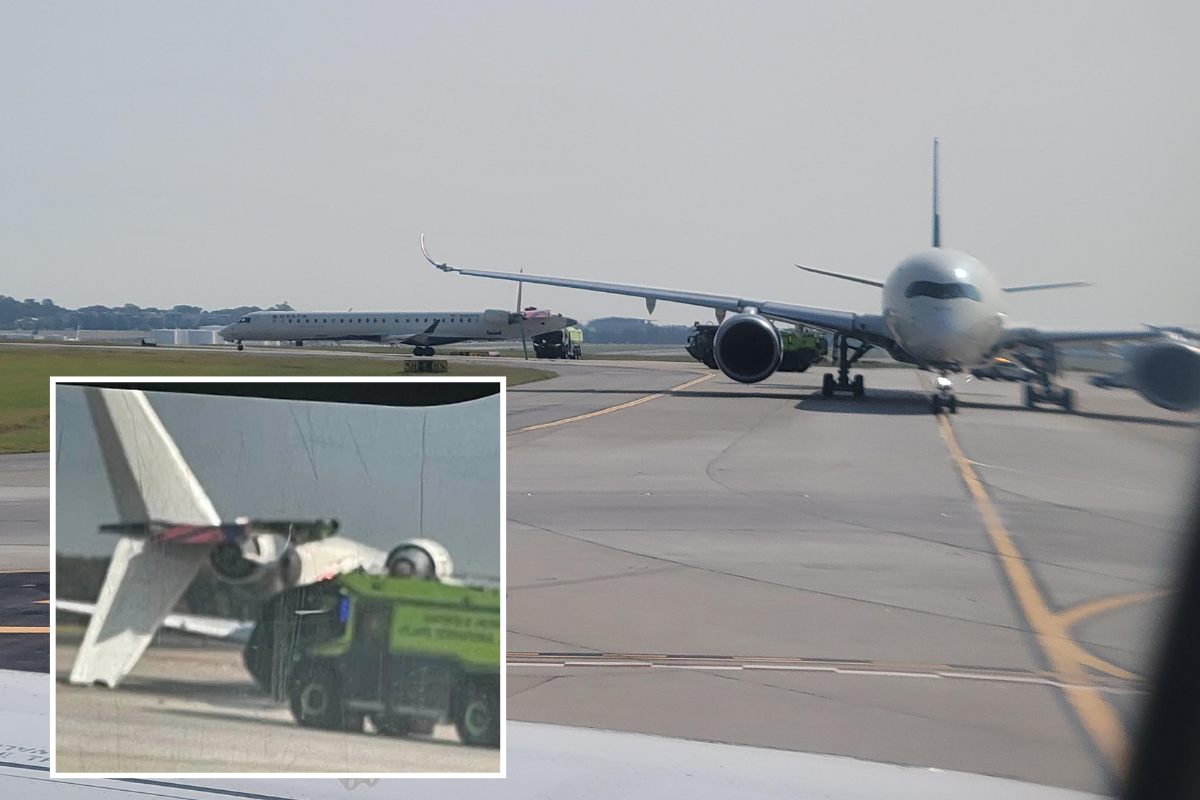
A regional jet operated by a wholly owned subsidiary of Delta Air Lines had its tail sliced off by a passing Delta Airbus A350 during an early morning accident at Atlanta International Airport on Tuesday.
Both aircraft were taxiing for takeoff when the six-year-old Airbus A350 collided with the back of the Delta Connection CRJ-900LR regional jet.
Dramatic photos taken from the airfield showed the CRJ-900LR’s tailfin hanging off the aircraft and damage to the right-hand wing tip of the Airbus A350 was also clearly visible.
Thankfully, none of the passengers or crew on either aircraft were injured as a result and, in a statement, Delta said the passengers were bussed back to the terminal building and booked onto alternative flights.
The CRJ regional jet is operated by Endeavor Air, which is owned by Delta Air Lines and operates the carrier’s Delta Connection branded regional flights. The decade-old jet was taxiing for departure for a flight between Atlanta and Lafayette at around 10 am on Tuesday.
Delta Connection operates several different configurations of its CRJ-900 with up to 70 passengers onboard, although Delta later confirmed that only 56 customers were aboard flight 5526.
The Delta Air Lines Airbus A350 with 221 passengers onboard was taxiing for departure as flight DL295 to Tokyo Haneda and departed the gate at around the same time as the much smaller CRJ regional jet.
Neither of the aircraft were under tow at the time of the accident, and the pilots would have been directed by air traffic controllers at Atlanta Hartsfield.
The CRJ-900 series has what is known as a T-Tail configuration in that the horizontal stabilizer is mounted on top of the vertical stabilizer which forms a ‘T’ shape.
There are several advantages to this design, after all, aircraft designers have to place the horizontal stabilizer somewhere, but it does also come with a number of risks.
One such risk, which appears to have been realized on Tuesday, is that the additional weight from the horizontal stabilizer can also put extra stress on the vertical stabilizer in the event of an aircraft clipping the tail.
In a statement, Delta Air Lines confirmed that there were no reported injuries and that it was cooperating with the NTSB and other authorities. A spokesperson told us:
“At approximately 10:07 a.m., the wing of an Airbus A350 taxiing out as DL295 from Atlanta to Tokyo-Haneda made contact with the tail of an Endeavor Air CRJ-900, DL5526 to LaFayette, Louisiana, on an adjacent taxiway, resulting in damage to the tail of the regional jet and the wing of the A350.”
“There have been no reported injuries at this time and customers are being transported back to the terminal where they will be reaccommodated on alternate flights.”
Mateusz Maszczynski honed his skills as an international flight attendant at the most prominent airline in the Middle East and has been flying ever since... most recently for a well known European airline. Matt is passionate about the aviation industry and has become an expert in passenger experience and human-centric stories. Always keeping an ear close to the ground, Matt's industry insights, analysis and news coverage is frequently relied upon by some of the biggest names in journalism.








The height and surface area of a T tail design does not give it an inherent risk. It is just a factor to be observed during ground operations, no different than the size of a 747 or any other aircraft.
On the contrary, the vertical tail on a T-tail airplane is actually shorter than a conventional tail. Mounting the horizontal at the tip of the vertical improves the efficiency of the vertical by reducing tip losses, and the vertical can thus be made smaller.
Worth noting too is that the vertical tail on a T-tail configuration is structurally stouter than a conventional tail because it has to carry the weight and flight loads of the horizontal tail on its tip.
According to the audio, the CRJ was holding at the intersection of F2 & E1, most likely for an intersection takeoff at E1 & RWY 8R, which is the normal eastbound takeoff runway on the north side of the airport. The A350, due to weight, will be using full length. Taxiway E, due to its width, is the normal “outbound” taxiway.. Taxiway F is the normal inbound taxiway with exception to wide body aircraft. With a wingspan of 212 feet +/-, there’s 106′ on the right side. The A350 wingtips are almost impossible to see from either side of the cockpit windows. Pilots are pretty good at taxiing on the yellow centerline which is surveyed to provide maximum clearance of the wingtips. IF the CRJ was hindered or just stopped short of completely clearing F2/E1 then it’s understandable that the A350 might take out the CRJs tail. It will also be interesting to hear the taxi clearance for both aircraft. Who said what to whom and what was repeated back. The damage should just buff out…starting with 5 grit sandpaper!